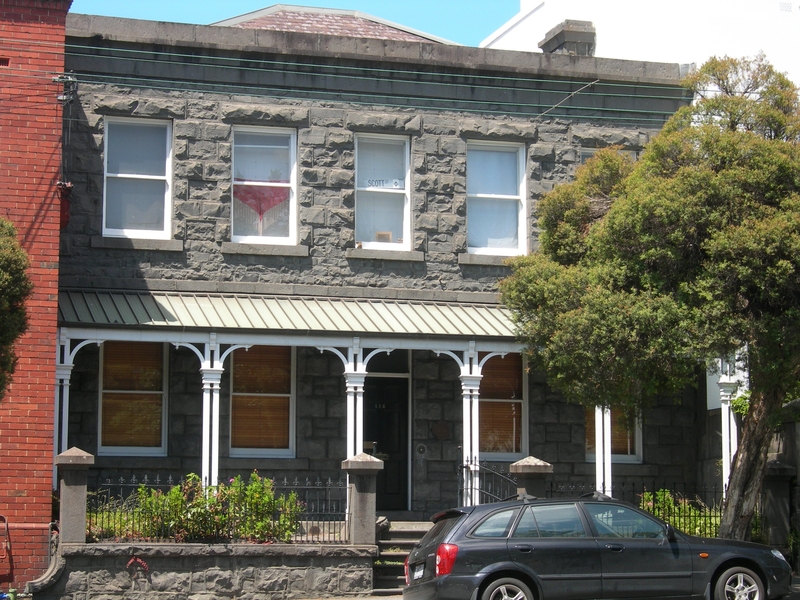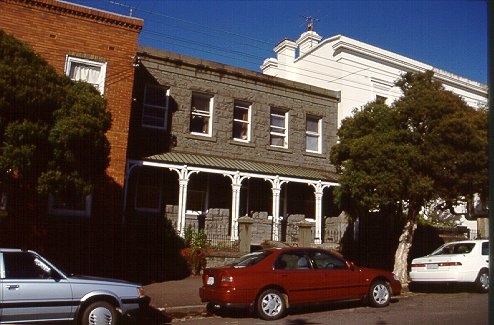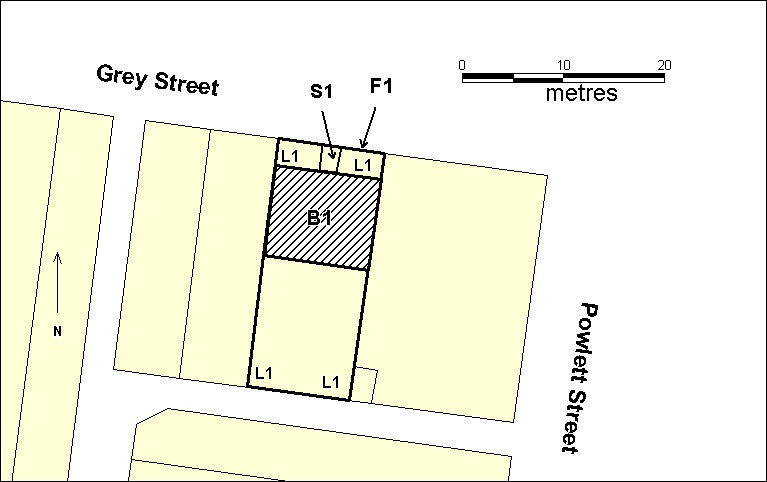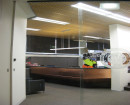TOWN HOUSE
115-117 GREY STREET EAST MELBOURNE, MELBOURNE CITY
-
Add to tour
You must log in to do that.
-
Share
-
Shortlist place
You must log in to do that.
- Download report







Statement of Significance
What is significant?
115 Grey Street is a two storey house built in early 1854. It was constructed only two years after the first Crown Allotment sales in East Melbourne. The walls are constructed of bluestone and the simple hipped roof is covered with slates. The symmetrical main facade is arranged as five bays with a horizontal emphasis. Masonry is ashlar quarry-faced bluestone with dressed quoins to all the openings and the wall returns. The main entrance is reached via bluestone steps which are flanked by a low bluestone wall with four pillars supporting a cast iron palisade fence. The fence complements the house although it is unlikely to date from 1854. The verandah is supported by six timber posts, each post comprising a pair of slim squared columns with simple capitals and quadrant bracket arms. The bracket arms terminate with delicate ornamental newel drops. The verandah roof is constructed from ribbed steel decking, an unfortunate replacement for what was originally corrugated iron sheeting. A small parapet completes the main facade. The rear facade of the original house is also symmetrical although composed of three rather than five bays. The rear stonework is irregular with thick mortar joints. Internally the house is simply arranged with four rooms to each floor about the central passageways running from the front to the rear. The layout from 1854 has been retained minus the internal stairs. A c1969 two storey breezeblock rear addition abuts the original structure.
How is it significant?
115 Grey Street is of historical and architectural significance to the State of Victoria.
Why is it significant?
115 Grey Street is historically significant as one of earliest houses in East Melbourne. The house had a long association from 1854 to 1907 with the family of its builder and first owner, that of successful grain merchant Thomas Wilson.
115 Grey Street is architecturally significant as an unusual example of the survival of the Georgian style in domestic Melbourne architecture of the early 1850s. Contributing to the restrained styling is the unadorned ashlar stonework, plain parapet and the quoins to the windows. The internal plan is intact, its symmetrical layout emulating the facade. The form of the house, set back from the street but built right up to the side boundaries is unusual for a single residential unit. The form contrasts to the fashion for speculative terrace housing which became prevalent in East Melbourne in the 1860s.
115 Grey Street is architecturally significant for its bluestone construction, unusual for an East Melbourne town house. Brick and weatherboard types were considerably more prevalent in the 1850s. Very few residential properties were constructed entirely of stone because of the relative expense, and the use of ashlar bluestone in 1854 clearly identifies the house as the home of a successful owner. The regular coursing of the stonework contrasts to nearby Bishopscourt which was built at a similar date but whose random stonework was clearly meant to be stuccoed over.
115 Grey Street is architecturally significant for its verandah. The verandah is unusual as an example of timber frame construction before the fashion for cast iron in the early 1860s.
-
-
TOWN HOUSE - History
Contextual History:
There was little development of East Melbourne before 1852 as the area remained reserved by the government. In 1848 Bishop Perry chose the area for his Anglican Bishop's Palace, built between 1848 and 1853 as Bishopscourt, with early twentieth century additions overlooking the Fitzroy Gardens. The first public land sales in East Melbourne took place in June 1852, when 20 allotments were sold off. Between 1852 and 1870 a total of 299 crown allotments were sold off. (Ashton and Wilson, East Melbourne Conservation Study, 1975)
In 1853 there were only four properties listed in the rate book for East Melbourne (W Burchett, East Melbourne 1837-1977 p 35).Possibly the earliest house built in East Melbourne after Bishopscourt was that of a bluestone cottage tendered for by architect Alfred Kursteiner in June 1853 (Argus 10 June 1853, six months before 115 Grey Street was built. Other early recorded houses in East Melbourne include two ‘imported’ houses in August 1853. Charles Laing tendered for the construction of stone foundations and chimneys for two imported houses in East Melbourne (Herald 24 August 1853) and the same architect tendered for the plastering of two houses, presumably the same ones, a couple of months later (Herald, 25 October 1853).
Development took off in the late 1850s after the gold rush had subsided. Many terraces were built speculatively for rental and lodging. In 1854 there were 85 properties, in 1855 177 properties. The residential area known as Yarra Park was bounded by Wellington Parade, Vale Street and Punt Road and was the site of the original police barracks. It was subdivided in the 1880s. After the Second World War East Melbourne became a popular area for boarding houses, and large mansions were regularly reordered by landlords to accommodate as many bedrooms as possible.
History of Place:
Thomas N Wilson was the original purchaser of the Crown Allotment on which 115 Grey Street was built. On December 8 1853 a building permit was applied for by Wilson to build a stone house. (Registration No.2252, Burchett Index). Construction is therefore likely to have begun in very early 1854. The architect is not definitely known. No architect is listed on the Building Permit application. However, it was probably Wharton & Burns, who tendered for the construction of a bluestone house in East Melbourne in December 1853, (Argus 9 December 1853 p.3) the day after the MCC permit application to build (Registration No.2252) by owner Thomas Wilson. It is believed that the original house was of eight rooms. The 1863 rate book describes the house as eight rooms and a stable, occupied by Mrs Pearce, a teacher of music. (C.Kellaway research Notes NT file no.189, 1975) In April 1862 Wilson applied for another permit to make alterations and additions to a bluestone cottage in Grey Street, on the south side just west of Powlett Street. This must be 115 Grey Street and should not be confused with a brick house that Wilson built the same year also in Grey Street. The additions must have consisted of three new rooms, because the house is described in 1868 rate books as being eleven rooms.(C.Kellaway research Notes NT file no.189) No further changes are evident in the building permits and the next clear evidence is provided by the MMBW plan of 1895. This shows 115 Grey Street with the familiar bluestone rectangular eight room structure at the front, and a rear addition. The rear addition is most likely accounted for by the documented 1862 alterations.
Stone houses in East Melbourne were uncommon. Of the 59 properties in East Melbourne in 1854 only 14 were of stone. In 1861 only 17 were stone out of 263. By 1870 38 properties were stone out of a total of 482. (W Burchett, East Melbourne 1837-1977 p 35).
The house has had only a handful of owners since 1854, although many more occupiers. Henry McDonough, another grain merchant, bought the house in 1907. (C.Kellaway research NT file no.189 ref. Rate Book Albert North Ward 1908 FB 126) Henry McDonough or members of his family continued to own 115 Grey Street until 1966. McDonough arrived in Victoria in 1863 and was considered by one source as one of the most prosperous grain merchants in Melbourne. (Cyclopedia of Victoria, vol.2 p.137 quoted in C Kellaway, research notes NT file no.189, 1977.)
In 1966 the house was purchased by the Lothbury Corporation for $17,500. During the late 1960s the existing brick rear addition was added at a cost of $16,000. (C Kellaway, NT research notes, FN183, 1977). The additions expanded the ground floor area considerably and this floor has been a surgery since that time. It was probably during the additions of the 1960s that the internal stair to the first floor was removed. Access to the upper storey is now only available from the rear, effectively giving separate access to the flat upstairs. The flat is leased and is physically independent from the surgery downstairs. It has been suggested by the current owners that no physical alterations have taken place since before 1979.
Associated People: Thomas Wilson
Geroge Wharton (architect) The architect of 115 Grey Street is not definitely known. No architect is listed on the Building Permit application. However, it is quite probably Wharton & Burns, who tendered for the construction of a bluestone house in East Melbourne in December 1853 (Argus 9 December 1853 p.3) the day after the MCC permit application to build (Registration No.2252) by owner Thomas Wilson. 115 Grey Street compares stylistically very closely to other work by George Wharton, for example the bluestone Grace Darling Hotel, Collingwood (H660)TOWN HOUSE - Assessment Against Criteria
a. The historical importance, association with or relationship to Victoria's history of the place or object
115 Grey Street is one of the oldest surviving houses in East Melbourne, possibly the oldest. It was built only a few years after the first land sales in East Melbourne.
b. The importance of a place or object in demonstrating rarity or uniqueness
115 Grey Street is constructed with ashlar bluestone. The high quality of this type of finish is unusual for a residence in Melbourne, particularly East Melbourne. The form of the house, set back from the street but built right up to the side boundaries is unusual for a single residential unit. The form contrasts to the fashion for speculative terrace housing which became prevalent in East Melbourne in the 1860s.
c. The place or object's potential to educate, illustrate or provide further scientific investigation in relation to Victoria's cultural heritage
d. The importance of a place or object in exhibiting the principal characteristics or the representative nature of a place or object as part of a class or type of places or objects
e. The importance of the place or object in exhibiting good design or aesthetic characteristics and/or in exhibiting a richness, diversity or unusual integration of features
The restrained Georgian-survival styling is unusual. The symmetrical five bay composition is suggestive of longer terraces such as Royal Terrace Nicholson Street but 115 Grey Street is a single residence.
f. The importance of the place or object in demonstrating or being associated with scientific or technical innovations or achievements
g The importance of the place or object in demonstrating social or cultural associations
TOWN HOUSE - Permit Exemptions
General Exemptions:General exemptions apply to all places and objects included in the Victorian Heritage Register (VHR). General exemptions have been designed to allow everyday activities, maintenance and changes to your property, which don’t harm its cultural heritage significance, to proceed without the need to obtain approvals under the Heritage Act 2017.Places of worship: In some circumstances, you can alter a place of worship to accommodate religious practices without a permit, but you must notify the Executive Director of Heritage Victoria before you start the works or activities at least 20 business days before the works or activities are to commence.Subdivision/consolidation: Permit exemptions exist for some subdivisions and consolidations. If the subdivision or consolidation is in accordance with a planning permit granted under Part 4 of the Planning and Environment Act 1987 and the application for the planning permit was referred to the Executive Director of Heritage Victoria as a determining referral authority, a permit is not required.Specific exemptions may also apply to your registered place or object. If applicable, these are listed below. Specific exemptions are tailored to the conservation and management needs of an individual registered place or object and set out works and activities that are exempt from the requirements of a permit. Specific exemptions prevail if they conflict with general exemptions. Find out more about heritage permit exemptions here.Specific Exemptions:General Conditions:
1. All exempted alterations are to be planned and carried out in a manner which prevents damage to the fabric of the registered place or object.
2. Should it become apparent during further inspection or the carrying out of alterations that original or previously hidden or inaccessible details of the place or object are revealed which relate to the significance of the place or object, then the exemption covering such alteration shall cease and the Executive Director shall be notified as soon as possible.
3. If there is a conservation policy and plan approved by the Executive Director, all works shall be in accordance with it.
4. Nothing in this declaration prevents the Executive Director from amending or rescinding all or any of the permit exemptions.
Nothing in this declaration exempts owners or their agents from the responsibility to seek relevant planning or building permits from the responsible authority where applicable.
Exterior
* Minor repairs and maintenance which replace like with like. Exception: steel decking to verandah should be replaced with corrugated iron sheeting.
* Removal of extraneous items such as air conditioners, pipe work, ducting, wiring, signage, antennae, aerials etc, and making good.
Interior
* Painting of previously painted walls and ceilings provided that preparation or painting does not remove evidence of earlier paint or other decorative scheme.
* Removal of paint from originally unpainted or oiled joinery, doors, architraves, skirtings and decorative strapping.
* Installation, removal or replacement of carpets and/or flexible floor coverings.
* Installation, removal or replacement of curtain track, rods, blinds and other window dressings.
* Installation, removal or replacement of hooks, nails and other devices for the hanging of mirrors, paintings and other wall mounted artworks.
* Refurbishment of bathrooms, toilets and or en suites including removal, installation or replacement of sanitary fixtures and associated piping, mirrors, wall and floor coverings.
* Installation, removal or replacement of kitchen benches and fixtures including sinks, stoves, ovens, refrigerators, dishwashers etc and associated plumbing and wiring.
* Installation, removal or replacement of ducted, hydronic or concealed radiant type heating provided that the installation does not damage existing skirtings and architraves and provided that the location of the heating unit is concealed from view.
* Installation, removal or replacement of split system air conditioning units provided that the installation does not damage existing skirtings and architraves and provided that the location of the cooling unit is concealed from view.
* Installation, removal or replacement of electrical wiring provided that all new wiring is fully concealed and any original light switches, pull cords, push buttons or power outlets are retained in-situ. Note: if wiring original to the place was carried in timber conduits then the conduits should remain in-situ.
* Installation, removal or replacement of bulk insulation in the roof space.
* Installation, removal or replacement of smoke detectors.
* Installation, removal or replacement of security locks to doors and windows.TOWN HOUSE - Permit Exemption Policy
The purpose of the permit exemptions is to allow works that do not impact on the significance of the place to take place without the need for a permit. The main importance of the town house at 115 Grey Street lies in the extant bluestone structure dating from early 1854. The rear brick additions dating from the late 1960s have no heritage significance and not part of the registration and no permit is required for demolition. The hierarchy of the original internal space in the 1854 structure can still be clearly understood and the removal of the stairs has not seriously compromised the layout of space. Structural internal alterations, including changes to walls, ceilings, openings and fireplaces will require a permit. All other non-structural alterations are dealt with by permit exemptions.
Externally, the owners are encouraged to replace the steel decking to the verandah with curved corrugated iron sheets.
-
-
-
-
-
RESIDENCE
 Victorian Heritage Register H0142
Victorian Heritage Register H0142 -
RESIDENCE
 Victorian Heritage Register H0143
Victorian Heritage Register H0143 -
PART OF FORMER FOY AND GIBSON COMPLEX
 Victorian Heritage Register H0896
Victorian Heritage Register H0896
-
..esterville
 Yarra City
Yarra City -
1 Alfred Crescent
 Yarra City
Yarra City -
1 Barkly Street
 Yarra City
Yarra City
-
-












